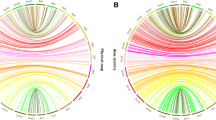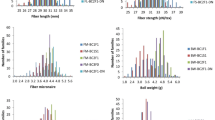Abstract
Knowledge of genetic relationships in crop breeding programs provides valuable information that can be used by plant breeders as a parental line selection tool. In Upland cotton (Gossypium hirsutum L.), the Pee Dee germplasm program represents one of the most historically significant Upland cotton breeding programs and is known as a key source of fiber quality genes for commercial cultivars. The foundation of the Pee Dee germplasm is known to represent an array of genetic diversity involving the hybridization of G. hirsutum L., G. barbadense L., and triple hybrid strains (G. arboreum L. × G. thurberi Todaro × G. hirsutum L.). In this study, we characterized genetic relationships within the Pee Dee germplasm collection using molecular marker and field performance data. Molecular marker and field performance data showed the Pee Dee germplasm collection still maintains useful amounts of genetic diversity. The methods described provide plant breeders of cotton and other crops a strategy to develop a parental line selection tool based on genotypic and phenotypic information. Cotton breeders can directly use the information provided to select specific Pee Dee germplasm parental line combinations based on genotypic (molecular marker) and phenotypic (field performance) information rather than relying on pedigree and phenotypic information alone.






Similar content being viewed by others
Abbreviations
- AFIS:
-
Advanced fiber information system
- HVI:
-
High volume instrument
- UPGMA:
-
Unweighted pair group method with arithmetic average
- SSR:
-
Simple sequence repeat
References
Abdalla AM, Reddy OUK, El-Zik KM, Pepper AE (2001) Genetic diversity and relationships of diploid and tetraploid cottons revealed using AFLP. Theor Appl Genet 102:222–229. doi:10.1007/s001220051639
Beasley JO (1940) The origin of American Gossypium species. Am Nat 74:285–286. doi:10.1086/280895
Beer SC, Goffreda J, Phillips TD, Murphy JP, Sorrells ME (1993) Assessment of genetic variation in Avena sterilis using morphological traits, isozymes, and RFLPs. Crop Sci 33:1386–1393
Blenda A, Scheffler J, Scheffler B, Palmer M, Lacape J-M, Yu J, Jesudurai C, Jung S, Muthukumar S, Yellambalase P, Ficklin S, Staton M, Eshelman R, Ulloa M, Saha S, Burr B, Liu S, Zhang T, Fang D, Pepper A, Kumpatla S, Jacobs J, Tomkins J, Cantrell R, Main D (2006) CMD: a cotton microsatellite database resource for Gossypium genomics. BMC Genomics 7:132. doi:10.1186/1471-2164-7-132
Bowman DT, Gutierrez OA (2003) Sources of fiber strength in the US upland cotton crop from 1980 to 2000. J Cotton Sci 7:164–169
Bowman DT, Gutierrez OA, Percy RG, Calhoun DS, May OL (2006) Pedigrees of Upland and Pima cotton cultivars released between 1970 and 2005. Bull. 1017. Miss. Agric. and For. Exp. Stn, Mississippi State, MS
Brown-Guedira GL, Thompson JA, Nelson RL, Warburton ML (2000) Evaluation of genetic diversity of soybean introductions and North American ancestors using RAPD and SSR markers. Crop Sci 40:815–823
Brubaker CL, Wendel JF (1994) Reevaluating the origin of domesticated cotton (Gossypium hirsutum, Malvaceae) using nuclear restriction fragment length polymorphism (RFLP). Am J Bot 81:1309–1326. doi:10.2307/2445407
Budak H, Pedraza F, Cregan PB, Baenziger PS, Dweikat I (2003) Development and utilization of SSRs to estimate the degree of genetic relationships in a collection of pearl millet germplasm. Crop Sci 43:2284–2290
Culp TW, Harrell DC (1973) Breeding methods for improving yield and fiber quality of upland cotton (Gossypium hirsutum L.). Crop Sci 13:686–689
Culp TW, Harrell DC (1979a) Registration of SC-1 cotton. Crop Sci 19:410
Culp TW, Harrell DC (1979b) Registration of five germplasm lines of cotton. Crop Sci 19:751
Culp TW, Harrell DC (1979c) Registration of Pee Dee 4461 cotton germplasm. Crop Sci 19:752
Culp TW, Harrell DC (1979d) Registration of Pee Dee 8619 germplasm line of cotton. Crop Sci 19:753
Culp TW, Harrell DC (1980a) Registration of medium staple cotton germplasm. Crop Sci 20:290
Culp TW, Harrell DC (1980b) Registration of three germplasm lines of cotton. Crop Sci 20:288–289
Culp TW, Harrell DC (1980c) Registration of extra-long staple cotton germplasm. Crop Sci 20:291
Culp TW, Moore RF, Pitner JB (1985a) Registration of PD-1 cotton. Crop Sci 25:198
Culp TW, Moore RF, Pitner JB (1985b) Registration of PD-2 cotton. Crop Sci 25:198–199
Culp TW, Moore RF, Pitner JB (1985c) Registration of seven cotton germplasm lines. Crop Sci 25:201–202
Culp TW, Moore RF, Harvey LH, Pitner JB (1988) Registration of ‘PD-3’ cotton. Crop Sci 28:190
Culp TW, Green CC, Kittrell BU (1990a) Registration of seven germplasm lines of upland cotton with resistance to bollworm, tobacco budworm, and boll weevil. Crop Sci 30:236–237
Culp TW, Green CC, Kittrell BU (1990b) Registration of twelve noncommercial germplasm lines of upland cotton with resistance to bollworm, tobacco budworm, and boll weevil. Crop Sci 30:236
Dice LR (1945) Measures of the amount of ecologic association between species. Ecology 26:297–302. doi:10.2307/1932409
Fufa H, Baenziger P, Beecher BS, Dweikat I, Graybosch R, Eskridge K (2005) Comparison of phenotypic and molecular marker-based classifications of hard red winter wheat cultivars. Euphytica 145:133–146. doi:10.1007/s10681-005-0626-3
Garris AJ, Tai TH, Coburn J, Kresovich S, McCouch S (2005) Genetic structure and diversity in Oryza sativa L. Genetics 169:1631–1638. doi:10.1534/genetics.104.035642
Green CC, Culp TW, Kittrell BU (1991a) Registration of four germplasm lines of upland cotton with early maturity and high fiber quality. Crop Sci 31:854
Green CC, Culp TW, Kittrell BU (1991b) Registration of five germplasm lines of upland cotton with high yield potential and fiber quality. Crop Sci 31:854–855
Green CC, Culp TW, Kittrell BU (1991c) Registration of two germplasm lines of upland cotton with highyield potential and fiber quality. Crop Sci 31:853
Gutierrez OA, Basu S, Saha S, Jenkins JN, Shoemaker DB, Cheatham CL, McCarty JC Jr (2002) Genetic distance among selected cotton genotypes and its relationship with F2 performance. Crop Sci 42:1841–1847
Hanson WD (1959) The breakup of initial linkage blocks under selected mating systems. Genetics 44:857–868
Harrell DC, Culp TW (1979a) Registration of Pee Dee 0259 and Pee Dee 2165 germplasm lines of cotton. Crop Sci 19:418
Harrell DC, Culp TW (1979b) Registration of Pee Dee 4381 germplasm line of cotton. Crop Sci 19:418
Institute SAS (2008) The SAS system for Windows, Release 9.2. SAS Inst, Cary, NC
Iqbal J, Reddy OUK, El-Zik KM, Pepper AE (2001) A genetic bottleneck in the ‘evolution under domestication’ of upland cotton Gossypium hirsutum L examined using DNA fingerprinting. Theor Appl Genet 103:547–554. doi:10.1007/PL00002908
Jiang C, Chee PW, Draye X, Morrell PL, Smith CW, Paterson AH (2000) Multilocus interactions restrict gene introgression in interspecific populations of polyploid Gossypium (cotton). Evol Int J Org Evol 54:798–814
Kerr T (1960) The trispecies hybrid ancestry of high strength cottons. Proc Cotton Imp Conf 21:82
Khan SA, Hussain D, Askari E, Stewart JM, Malik KA, Zafar Y (2000) Molecular phylogeny of Gossypium species by DNA fingerprinting. Theor Appl Genet 101:931–938. doi:10.1007/s001220051564
Labate JA, Lamkey KR, Mitchell SE, Kresovich S, Sullivan H, Smith JSC (2003) Molecular and historical aspects of corn belt Dent diversity. Crop Sci 43:80–91
Lacape J-M, Dessauw D, Rajab M, Noyer J-L, Hau B (2007) Microsatellite diversity in tetraploid Gossypium germplasm: assembling a highly informative genotyping set of cotton SSRs. Mol Breed 19:45–58. doi:10.1007/s11032-006-9042-1
Liu S, Cantrell RG, McCarty JC Jr, Stewart JM (2000) Simple sequence repeat-based assessment of genetic diversity in cotton race stock accessions. Crop Sci 40:1459–1469
Lu HJ, Myers GO (2002) Genetic relationships and discrimination of ten influential Upland cotton varieties using RAPD markers. Theor Appl Genet 105:325–331. doi:10.1007/s00122-002-0947-8
May OL (1999) Registration of PD 94042 germplasm line of upland cotton with high yield and fiber maturity. Crop Sci 39:597–598
May OL (2001) Registration of PD 94045 germplasm line of upland cotton. Crop Sci 41:279–280
May OL, Howle DS (1997a) Registration of six germplasm lines of upland cotton: PD 93009, PD 93019, PD 93021, PD 93030, PD 93034, and PD 93057. Crop Sci 37:1030–1031
May OL, Howle DS (1997b) Registration of three germplasm lines of upland cotton: PD 93007, PD 93043, and PD 93046. Crop Sci 37:1030
May OL, Bowman DT, Calhoun DS (1995) Genetic diversity of U.S. upland cotton cultivars releases between 1980 and 1990. Crop Sci 35:1570–1574
May OL, Howle DS, Green CC, Culp TW (1996) Registration of PD-3-14 germplasm line of upland cotton with high yield and fiber quality. Crop Sci 36:1718
Meredith WR Jr (2005) Minimum number of genes controlling cotton fiber strength in a backcross population. Crop Sci 45:1114–1119. doi:10.2135/cropsci2003.0425
Milla SR, Isleilb TR, Stalker HT (2005) Taxonomic relationships among Arachis sect Arachis species as revealed by AFLP markers. Genome 48:1–11. doi:10.1139/g04-089
Mohammadi SA, Prasanna BM (2003) Analysis of genetic diversity in crop plants-salient statistical tools and considerations. Crop Sci 43:1235–1248
Nei M, Li W (1979) Mathematical model for studying genetic variation in terms of restriction endonucleases. Proc Natl Acad Sci USA 76:5269–5273. doi:10.1073/pnas.76.10.5269
Nguyen T-B, Giband M, Brottier P, Risterucci A-M, Lacape J-M (2004) Wide coverage of the tetraploid cotton genome using newly developed microsatellite markers. Theor Appl Genet 109:167–175. doi:10.1007/s00122-004-1612-1
Pillay M, Myers GO (1999) Genetic diversity in cotton assessed by variation in ribosomal RNA genes and AFLP markers. Crop Sci 39:1881–1886
Rahman M, Hussain D, Zafar Y (2002) Estimation of genetic divergence among elite cotton cultivars-genotypes by DNA fingerprinting technology. Crop Sci 42:2137–2144
Rohlf FJ (2005) NTSYSpc, numerical taxonomy and multivariate analysis system, version 2.2. Applied Biostatistics Inc, New York
Smith CW, Cantrell RG, Moser HS, Oakley SR (1999) History of cultivar development in the United States. In: Smith CW, Cothren JT (eds) Cotton: origin, history, technology, and production. John Wiley & Sons Inc, New York, pp 99–171
Tatineni V, Cantrell RG, Davis DD (1996) Genetic diversity in elite cotton germplasm determined by morphological characteristics and RAPDs. Crop Sci 36:186–192
Van Becelaere G, Lubbers EL, Paterson AH, Chee PW (2005) Pedigree- vs DNA marker-based genetic similarity estimates in cotton. Crop Sci 45:2281–2287. doi:10.2135/cropsci2004.0715
Van Esbroeck G, Bowman DT, Calhoun DS, May OL (1998) Changes in the genetic diversity of cotton in the USA from 1970 to 1995. Crop Sci 38:33–37
Van Esbroeck G, Bowman D, May O, Calhoun D (1999) Genetic similarity indices for ancestral cotton cultivars and their impact on genetic diversity estimates of modern cultivars. Crop Sci 39:323–328
Wang K, Song X, Han Z, Guo W, Yu J, Sun J, Pan J, Kohel R, Zhang T (2006) Complete assignment of the chromosomes of Gossypium hirsutum L by translocation and fluorescence in situ hybridization mapping. Theor Appl Genet 113:73–80. doi:10.1007/s00122-006-0273-7
Wendel JF, Brubaker CL, Percival AE (1992) Genetic diversity in Gossypium hirsutum and the origin of Upland cotton. Am J Bot 79:1291–1310. doi:10.2307/2445058
Zhang J, Lu Y, Cantrell RG, Hughs E (2005a) Molecular marker diversity and field performance in commercial cotton cultivars evaluated in the southwestern USA. Crop Sci 45:1483–1490. doi:10.2135/cropsci2004.0581
Zhang JF, Lu Y, Adragna H, Hughs E (2005b) Genetic improvement of New Mexico Acala cotton germplasm and their genetic diversity. Crop Sci 45:2363–2373. doi:10.2135/cropsci2005.0140
Acknowledgments
This research project was supported by funding from CRIS No. 6657-21000-005-00D of the U.S. Department of Agriculture and a grant from Cotton Incorporated. Special thanks to Bobby Fisher and summer students for technical assistance. Mention of trade names or commercial products in this publication is solely for the purpose of providing specific information and does not imply recommendation or endorsement by the U.S. Department of Agriculture.
Author information
Authors and Affiliations
Corresponding author
Rights and permissions
About this article
Cite this article
Campbell, B.T., Williams, V.E. & Park, W. Using molecular markers and field performance data to characterize the Pee Dee cotton germplasm resources. Euphytica 169, 285–301 (2009). https://doi.org/10.1007/s10681-009-9917-4
Received:
Accepted:
Published:
Issue Date:
DOI: https://doi.org/10.1007/s10681-009-9917-4




